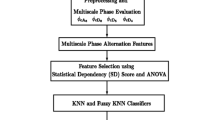Abstract
Myocardial infarction (MI) is the alarming symbol of heart attack which causes the heart muscles to get damaged due to MI which leading to death. The early diagnosis and detection of symptoms based on myocardial infarction are extremely necessary to reduce probability of death of the patient. The main objective of this work is to develop a classification framework for electrocardiogram (ECG) signals using morphological, time domain, and empirical mode decomposition (EMD) features to classify between MI and healthy control (HC). The PTBDB database was used to test the whole experiment. A logistic model trees (LMT) classifier is proposed to classify the MI and HC samples. As per the experimental study for detection of MI and HC, the classifier achieves an accuracy of 98.75% over fusion of features.
Access this chapter
Tax calculation will be finalised at checkout
Purchases are for personal use only
Similar content being viewed by others
References
Roger VL, Go AS et al (2012) Heart disease and stroke statistics-2012 update. Circulation 125(1):e2–e220
Mehra R (2007) Global public health problem of sudden cardiac death. J Electrocardiol 40(6):S118–S122
Haykin S (2002) Neural networks. Pearson Education Asia, New Delhi
Schamroth L (2009) An Introduction to electrocardiography, 7th edn. Wiley, New York, NY, USA
Reddy MRSE, Svensson L, Haisty J, Pahlm WK (1992) Neural network versus electrocardiographer and conventional computer criteria in diagnosing anterior infarct from the ECG. In: Proceedings of computers in cardiology, pp 667–670
Diker ZC, Avci E, Velappan S (2018) Intelligent system based on genetic algorithm and support vector machine for detection of myocardial infarction from ECG signals. In: 2018 26th Signal processing and communications applications conference (SIU), pp 1–4. https://doi.org/10.1109/SIU.2018.8404299
Padhy S, Dandapat S (2017) Third-order tensor based analysis of multilead ECG for classification of myocardial infarction. Biomed Sig Process Control 31:71–78. ISSN 1746-8094
Dohare AK, Kumar V, Kumar R (2018) Detection of myocardial infarction in 12 lead ECG using support vector machine. Appl Soft Comput 64:138–147
Baloglu UB, Talo M, Yildirim O, Tan RS, Acharya UR (2019) Classification of myocardial infarction with multi-lead ecg signals and deep cnn Pattern Recognit. Lett 122:23–30. https://doi.org/10.1016/j.patrec.2019.02.016
Goldberger AL, Amaral LAN, Glass L, Hausdorff JM, Ivanov PC, Mark RG, Mietus JE, Moody GB, Peng CK, Stanley HE (2000) PhysioBank, PhysioToolkit, and PhysioNet—components of a new research resource for complex physiologicsignals. Circulation 101:e215–e220
Sahoo S, Mohanty M, Behera S, Sabut SK (2017) ECG beat classification using empirical mode decomposition and mixture of features. J Med Eng Technol 41(8):652–661
Riaz F, Hassan A, Rehman S, Niazi IK, Dremstrup K (2016) EMD based temporal and spectral features for the classification of EEG signals using supervised learning. IEEE Trans Neural Syst Rehabil Eng 24(1):28–35
Landwehr N, Hall M, Frank E (2005) Logistic model trees. Mach Learn 59(1/2):161–205
Author information
Authors and Affiliations
Corresponding author
Editor information
Editors and Affiliations
Rights and permissions
Copyright information
© 2022 The Author(s), under exclusive license to Springer Nature Singapore Pte Ltd.
About this paper
Cite this paper
Sahoo, S., Patra, G.R., Mohanty, M., Samanta, S. (2022). Automated Detection of Myocardial Infarction with Multi-lead ECG Signals using Mixture of Features. In: Mohanty, M.N., Das, S. (eds) Advances in Intelligent Computing and Communication. Lecture Notes in Networks and Systems, vol 430. Springer, Singapore. https://doi.org/10.1007/978-981-19-0825-5_35
Download citation
DOI: https://doi.org/10.1007/978-981-19-0825-5_35
Published:
Publisher Name: Springer, Singapore
Print ISBN: 978-981-19-0824-8
Online ISBN: 978-981-19-0825-5
eBook Packages: Intelligent Technologies and RoboticsIntelligent Technologies and Robotics (R0)




